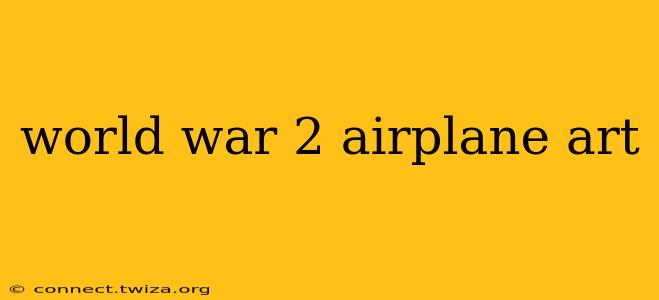World War II left an indelible mark on the world, and its impact resonates even today. Beyond the historical accounts and somber statistics, the conflict also inspired a vibrant and diverse artistic movement, particularly in the realm of aviation art. World War II airplane art captures the spirit of the era, portraying the machines of war, the men and women who flew them, and the landscapes they traversed. This art offers a unique window into the conflict, revealing not only the technological advancements but also the human drama unfolding in the skies above. From meticulously detailed renderings to evocative impressionistic pieces, the artistry reflects the emotional intensity and historical significance of the war.
What are the different styles of WWII airplane art?
The styles employed in WWII airplane art are as varied as the artists themselves. Some artists favored a highly realistic approach, focusing on precise detail and accuracy in depicting aircraft and their markings. These pieces often serve as historical documents, preserving the visual record of specific aircraft and squadrons. Others adopted a more impressionistic or abstract style, using color and form to convey the emotion and atmosphere of aerial combat. This approach might emphasize the drama of a dogfight, the loneliness of a long-range patrol, or the sheer power of the machines involved. Furthermore, propaganda posters featuring airplanes were prevalent, using bold imagery and simple messages to rally support for the war effort.
What types of aircraft are commonly featured in WWII airplane art?
The aircraft depicted in WWII airplane art are as diverse as the conflict itself. Iconic fighters like the Spitfire, Mustang, Zero, and Messerschmitt Bf 109 are frequently featured, often captured in dramatic aerial combat scenes. Bombers such as the B-17 Flying Fortress and Lancaster are also prominent subjects, reflecting the strategic bombing campaigns that shaped the war's course. Less commonly seen, but equally significant, are depictions of transport aircraft and support planes, highlighting the often-overlooked roles of these crucial machines. The choice of aircraft often reflects the artist's national perspective or their specific experiences during the war.
How did WWII airplane art reflect the experiences of pilots and air crews?
World War II airplane art often served as a powerful means of expressing the personal experiences of pilots and aircrews. Many works capture the camaraderie and shared dangers faced by these men and women, emphasizing the bonds forged in the face of adversity. Some paintings depict the intense pressure and psychological strain of aerial combat, while others focus on the moments of respite and reflection experienced between missions. These pieces offer a glimpse into the human cost of war, moving beyond the technical aspects of the aircraft to focus on the emotional lives of those who flew them.
Where can I find examples of WWII airplane art?
Examples of WWII airplane art can be found in various places. Many museums dedicated to military history or aviation feature collections of original artwork and prints. Private collections also house numerous pieces, with some available for public viewing through exhibitions and online galleries. Books and magazines focusing on military history and aviation art frequently reproduce notable works. Online resources and auction sites also offer opportunities to view and potentially acquire examples of this captivating art form. Remember to always verify authenticity and provenance when purchasing any artwork.
Is WWII airplane art still being created today?
Yes, WWII airplane art continues to be created today. Many contemporary artists are inspired by the history and imagery of the war, producing new works that reflect both the classic styles and modern interpretations. This continued interest shows the lasting impact of the conflict and the enduring appeal of aviation art. The focus may shift from purely historical accuracy to more artistic explorations of the themes and emotions associated with the war, but the subject matter maintains its relevance and powerful presence.
By exploring the diverse styles, subjects, and perspectives within World War II airplane art, we gain a deeper appreciation for the history of the conflict and the human stories it encompasses. It's more than just a depiction of machines; it's a reflection of courage, sacrifice, and the enduring power of the human spirit.
